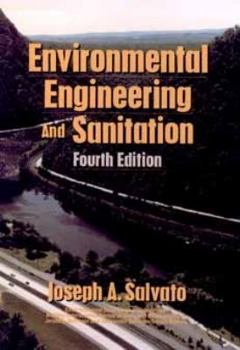Environmental Engineering and Sanitation
Updated to cover new laws and standards, including Federal Safe Drinking Act, the Resource Conservation and Recovery Act, and the Clean Air Act of 1990. Applies sanitation and engineering theory and principles to environmental control in urban, suburban and rural communities. Engineering design, construction, operation and maintenance details are provided throughout as they relate to plants and structures. Topics include: disease control, water supply,...
Format:Hardcover
Language:English
ISBN:0471523771
ISBN13:9780471523772
Release Date:May 1992
Publisher:Wiley-Interscience
Length:1456 Pages
Weight:4.40 lbs.
Dimensions:2.4" x 6.5" x 9.6"
Customer Reviews
4 ratings
Great Text For Environmental Design Management ! Flawless!
Published by Thriftbooks.com User , 18 years ago
I live, study and work in the New York Tri-State region and this book is pretty great because the author also lived, worked and studied in the same region. Whats good about that? The Human Development and Expliotation is our region is very diverse and often connects directly with other prominent regions around the globe. The author basically covers alot of legalities, origins, design principles, and field work analysis really well. This was one of the easier to read text in my classes, not because it is written in laymans terms, but he writes the ideas in a clear concise manner and covers alot of material with great efficiency using (the best I've seen in any enviro-engineering text) superb diaghrams, pictures and charts. As a whole I felt the text demystifies alot of what this field is about so I usually recommend it to other non-environmental engineers, planners and designers that I come across in my school and work. The book is expensive but I felt it was one of those few (if any) books you'll ever buy in college that is worth every penny. This one is a keeper!
GREATEST ENVIRONMENTAL ENGINEERING BOOK
Published by Thriftbooks.com User , 25 years ago
GREAT!!!!!
94 S: Excellent Resource, Environmental Health professionals
Published by Thriftbooks.com User , 26 years ago
I have just reviewed the ENVIRONMENTAL ENGINEERING AND SANITATION 1994 SUPPLEMENT, by Joseph A. Salvato and Joe E. Beck. It's a great resource for professionals seeking a broader vision of environmental health practice areas and where we are heading. Prof. Beck obviously put a lot of work into conceptualizing this volume and working with the distinguished contributors. It shows. In particular, I found the first chapter, Stakeholder Focused Interactive Planning (SFIP)by Joe Beck and Steven Ison to be a brilliant piece on the desirability of (indeed, the imperative for our profession to) include the public in problem-solving and planning. I have used this process and mediated disputes ranging from siting controversies (haz. waste facility siting in Massachusetts) to determining future land use options at Hanford in the nuclear weapons complex. I commend both Beck and Ison for their clear portrayal of the paradigm as well as the steps one undertakes in conducting such planning. Federal government engineers and planners have been learning the hard way about what happens when decisions are made without public input and without regard to the values, interests, and expectations of so-called stakeholders. At Hanford, more than $20 billion in appropriations has yielded preciously little in terms of actual cleanup: one may wonder if Congress will continue to appropriate the substantial $6 billion a year for the Dept. of Energy's Environmental Management Program without consensus of the public on #1) the benefits or #2) the ameliorated risks from present expenditures. Current stakeholders come from a wide range of public interest groups and they do not get along particularly well. They do not have current programs or projects that reflect the use of the SFIP and researchers should be asking themselves, "Why not?" (Resources for the Future [RFF] has an on-going research project that tackles public participation in environmental decision making).I would also like to comment on Ch. 6 "The Institutional Environment: Biosafety" by Darly Rowe. The importance of Dr. Rowe's conclusion that we must rely on consultation and working with the client on biosafety issues cannot be overstated. I also like the typology which places biosafety issues in proper perspective. We seem to be deluged with risks and risk information, and his approach is clear, concise and elegant. In sum, I believe that environmental health professionals can apply the insights in this series of articles in a way that will help supplant the "command-and-control" mentatlity that has battered so many of our colleagues and public health/environment inspectors, and baffled decision makers in the past two decades. Asst. Prof. R. Steven Konkel, Ph.D., EKU
Excellent reference book with questionable publisher support
Published by Thriftbooks.com User , 27 years ago
This text is one of the most definitive AND USEFUL shelf references for the environmental health sciences. Detailed, accurate, wide-ranging on topics of immediate interest to the practicing sanitarian, engineer or the very interested non-practitioner. Support from the publisher has been poor. For two years after the announcement of the current addendum, the publisher "disavowed knowledge" of an addendum. When published, the addendum had the same ISBN number as the complete text -- creating the unture appearance of a "reduced" price complete addition. Salvato, could for the price of this text, be on a more current update of information contained in some chapters (2-3 year cycle). The scope of this work would justify numerous consulting authors. While it is one of the best shelf references and "learning texts" it could still be improved and be better supported by a publisher that sometimes seems to have insulated itself from the buying public.





